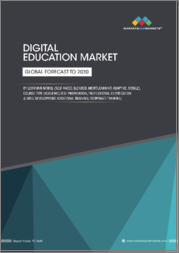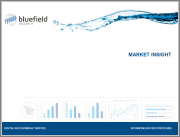
|
시장보고서
상품코드
1782437
세계의 디지털 교육 시장 조사 보고서 : 산업 분석, 규모, 점유율, 성장, 동향, 예측(2025-2033년)Global Digital Education Market Research Report- Industry Analysis, Size, Share, Growth, Trends and Forecast 2025 to 2033 |
||||||
세계의 디지털 교육 시장 규모는 2024년 280억 5,000만 달러에서 2033년에는 2,422억 8,000만 달러로 성장할 것으로 예측되며, 2026-2033년의 예측 기간 중 27.07%의 견고한 연평균 성장률(CAGR)을 나타냅니다.
디지털 교육 시장은 기술이 학습과 교육의 풍경을 계속 재구성하고 있으므로 현저한 변화를 겪고 있습니다. 온라인 학습 플랫폼의 도입이 확대됨에 따라 교육 기관은 디지털 툴을 활용하여 학습 경험을 개선하고 더 많은 청중에게 다가갈 수 있도록 노력하고 있습니다. 가상 교실, 인터랙티브 컨텐츠, 모바일 학습 용도과 같은 e-learning 솔루션에 대한 수요는 학생과 교육 관계자들이 유연하고 접근하기 쉬운 교육의 장점을 인식함에 따라 급증하고 있습니다. 디지털 교육 시장이 진화함에 따라 다양한 학습 스타일과 취향에 대응하는 혁신적인 솔루션에 대한 요구가 높아지면서 시장은 크게 확대될 것으로 예측됩니다.
또한 인공지능과 데이터 분석을 디지털 교육 플랫폼에 통합하여 개별화 학습에 혁명을 일으키고 있습니다. AI를 활용한 시스템은 학생들의 성적과 학습 노력을 분석하여 학습 경험을 향상시킬 수 있는 맞춤형 권장 사항과 리소스를 제공할 수 있습니다. 이러한 수준의 커스터마이징은 교육 성과를 향상시킬 뿐만 아니라 학습자에게 더욱 매력적이고 동기부여가 되는 환경을 조성합니다. 교육 기관이 이러한 기술을 점점 더 많이 채택함에 따라 디지털 교육 시장은 계속 성장하여 학습자와 교육자 모두에게 새로운 기회를 제공하게 될 것입니다.
또한 평생학습으로의 전환은 디지털 교육 시장을 더욱 촉진하고 있습니다. 시시각각 변화하는 고용 시장에서 개인들이 기술 향상과 재교육을 원함에 따라 온라인 강좌와 전문성 개발 프로그램에 대한 수요는 지속적으로 증가하고 있습니다. 이러한 추세는 특히 기술, 헬스케어, 금융 등 경력 발전을 위해 지속적인 학습이 필수적인 산업에서 두드러지게 나타나고 있습니다. 이처럼 디지털 교육 시장은 기술 발전, 개인화된 학습 경험에 대한 요구, 빠르게 진화하는 세계에서 평생 교육에 대한 중요성이 높아지면서 큰 성장이 예상되고 있습니다.
당사의 보고서는 고객에게 다양한 산업과 시장에 대한 종합적이고 실용적인 인사이트를 제공하기 위해 세심하게 작성되었습니다. 각 보고서는 시장 상황을 완전히 이해하기 위해 몇 가지 중요한 요소를 포함하고 있습니다.
시장 개요: 정의, 분류, 산업 현황 등 시장에 대한 자세한 소개.
시장 역학: 시장 성장에 영향을 미치는 주요 촉진요인, 억제요인, 기회 및 과제를 상세하게 분석합니다. 이 섹션에서는 기술 발전, 규제 변화, 새로운 동향 등의 요인을 살펴봅니다.
세분화 분석 : 제품 유형, 용도, 최종사용자, 지역 등의 기준에 따라 시장을 명확한 부문으로 세분화합니다. 이 분석을 통해 각 부문의 실적과 미래성을 파악할 수 있습니다.
경쟁 구도: 시장 점유율, 제품 포트폴리오, 전략적 구상, 재무 실적 등 주요 시장 진출기업의 종합적인 평가. 주요 기업이 채택하고 있는 경쟁 역학 및 주요 전략에 대한 인사이트을 담고 있습니다.
시장 예측 : 과거 데이터와 현재 시장 상황을 바탕으로 일정 기간 시장 규모와 성장 추세를 예측합니다. 여기에는 정량적 분석과 미래 시장 궤적을 보여주는 그래프 표시가 포함됩니다.
지역 분석 : 지역별 시장 성과를 평가하고 주요 시장 및 지역 동향을 파악합니다. 지역 시장 역학 및 비즈니스 기회를 이해하는 데 도움이 됩니다.
새로운 동향과 기회 : 현재 시장 동향과 새로운 시장 동향, 기술 혁신, 잠재적 투자 대상 부문을 식별합니다. 향후 개발 및 성장 전망에 대한 인사이트를 담고 있습니다.
목차
제1장 서문
제2장 개요
- 시장의 하이라이트
- 세계 시장 스냅숏
제3장 디지털 교육 산업 분석
- 서론 : 시장 역학
- 시장 성장 촉진요인
- 시장 성장 억제요인
- 기회
- 산업 동향
- Porter's Five Forces 분석
- 시장의 매력 분석
제4장 밸류체인 분석
- 밸류체인 분석
- 원료 분석
- 원료 리스트
- 원료 제조업체 리스트
- 주요 원료의 가격 동향
- 잠재적 바이어 리스트
- 마케팅 채널
- 직접 마케팅
- 간접 마케팅
- 마케팅 채널 발전 동향
제5장 세계의 디지털 교육 시장 분석 : 학습 유형별
- 학습 유형별 개요
- 학습 유형별 과거·예측 데이터 분석
- 자기 페이스 강사 주도형 온라인 교육
- 강사 주도형 온라인 교육
제6장 세계의 디지털 교육 시장 분석 : 코스 유형별
- 코스 유형별 개요
- 코스 유형별 과거·예측 데이터 분석
- 과학기술 코스
- 기업·경영 코스
- 기타
제7장 세계의 디지털 교육 시장 분석 : 최종사용자별
- 최종사용자별 개요
- 최종사용자별 과거·예측 데이터 분석
- 개인 학습자·교육 기관
- 기업
- 정부기관
제8장 세계의 디지털 교육 시장 분석 : 지역별
- 지역별 전망
- 서론
- 북미의 판매 분석
- 개요, 실적과 예측
- 북미 : 부문별
- 북미 : 국가별
- 미국
- 캐나다
- 멕시코
- 유럽의 판매 분석
- 개요, 실적과 예측
- 유럽 : 부문별
- 유럽 : 국가별
- 영국
- 프랑스
- 독일
- 이탈리아
- 러시아
- 기타 유럽
- 아시아태평양의 판매 분석
- 개요, 실적과 예측
- 아시아태평양 : 부문별
- 아시아태평양 : 국가별
- 중국
- 인도
- 일본
- 한국
- 호주
- 동남아시아
- 기타 아시아태평양
- 라틴아메리카의 판매 분석
- 개요, 실적과 예측
- 라틴아메리카 : 부문별
- 라틴아메리카 : 국가별
- 브라질
- 아르헨티나
- 페루
- 칠레
- 기타 라틴아메리카
- 중동 및 아프리카의 판매 분석
- 개요, 실적과 예측
- 중동 및 아프리카 : 부문별
- 중동 및 아프리카 : 국가별
- 사우디아라비아
- 아랍에미리트
- 이스라엘
- 남아프리카공화국
- 기타 중동 및 아프리카
제9장 디지털 교육 기업의 경쟁 구도
- 디지털 교육 시장의 경쟁
- 제휴·협력·계약
- 합병·인수
- 신제품 발매
- 기타 개발
제10장 기업 개요
- 상위 기업의 시장 점유율 분석
- 시장 집중도
- Coursera Inc.
- Pluralsight LLC
- Alison
- Udacity Inc.
- Udemy Inc.
- MirA-Adax
- Jigsaw Academy
- Intellipaat Edmodo
- FutureLearn
Global Digital Education Market size is anticipated to grow from USD 28.05 Billion in 2024 to USD 242.28 Billion by 2033, showcasing a robust Compound Annual Growth Rate (CAGR) of 27.07% during the forecast period of 2026 to 2033.
The digital education market is experiencing a remarkable transformation as technology continues to reshape the landscape of learning and teaching. With the increasing adoption of online learning platforms, educational institutions are leveraging digital tools to enhance the learning experience and reach a broader audience. The demand for e-learning solutions, including virtual classrooms, interactive content, and mobile learning applications, is surging as students and educators alike recognize the benefits of flexible and accessible education. As the digital education market evolves, it is expected to expand significantly, driven by the need for innovative solutions that cater to diverse learning styles and preferences.
Moreover, the integration of artificial intelligence and data analytics into digital education platforms is revolutionizing personalized learning. AI-driven systems can analyze student performance and engagement, providing tailored recommendations and resources that enhance the learning experience. This level of customization not only improves educational outcomes but also fosters a more engaging and motivating environment for learners. As educational institutions increasingly adopt these technologies, the digital education market will continue to grow, offering new opportunities for both learners and educators.
Additionally, the global shift towards lifelong learning is further propelling the digital education market. As individuals seek to upskill and reskill in an ever-changing job market, the demand for online courses and professional development programs is on the rise. This trend is particularly relevant in industries such as technology, healthcare, and finance, where continuous learning is essential for career advancement. The digital education market is thus positioned for significant growth, driven by technological advancements, the need for personalized learning experiences, and the increasing emphasis on lifelong education in a rapidly evolving world.
Our reports are meticulously crafted to provide clients with comprehensive and actionable insights into various industries and markets. Each report encompasses several critical components to ensure a thorough understanding of the market landscape:
Market Overview: A detailed introduction to the market, including definitions, classifications, and an overview of the industry's current state.
Market Dynamics: In-depth analysis of key drivers, restraints, opportunities, and challenges influencing market growth. This section examines factors such as technological advancements, regulatory changes, and emerging trends.
Segmentation Analysis: Breakdown of the market into distinct segments based on criteria like product type, application, end-user, and geography. This analysis highlights the performance and potential of each segment.
Competitive Landscape: Comprehensive assessment of major market players, including their market share, product portfolio, strategic initiatives, and financial performance. This section provides insights into the competitive dynamics and key strategies adopted by leading companies.
Market Forecast: Projections of market size and growth trends over a specified period, based on historical data and current market conditions. This includes quantitative analyses and graphical representations to illustrate future market trajectories.
Regional Analysis: Evaluation of market performance across different geographical regions, identifying key markets and regional trends. This helps in understanding regional market dynamics and opportunities.
Emerging Trends and Opportunities: Identification of current and emerging market trends, technological innovations, and potential areas for investment. This section offers insights into future market developments and growth prospects.
SEGMENTATION COVERED IN THE REPORT
By Learning Type
- Self-Paced Instructor-Led Online Education
- Instructor-Led Online Education
By Course Type
- Science and Technology Courses
- Entrepreneurship and Business Management Courses
- Others
By End-User
- Individual Learners and Academic Institutions
- Enterprises
- Government Organizations
- COMPANIES PROFILED
- Coursera Inc.
- Pluralsight LLC
- Alison
- Udacity Inc.
- Udemy Inc.
- Miriadax
- Jigsaw Academy
- Intellipaat Edmodo
- FutureLearn.
- The above list can be customized.
TABLE OF CONTENTS
1. PREFACE
- 1.1. Report Description
- 1.1.1 Objective
- 1.1.2 Target Audience
- 1.1.3 Unique Selling Proposition (USP) & offerings
- 1.2. Research Scope
- 1.3. Research Methodology
- 1.3.1 Market Research Process
- 1.3.2 Market Research Methodology
2. EXECUTIVE SUMMARY
- 2.1. Highlights of Market
- 2.2. Global Market Snapshot
3. DIGITAL EDUCATION INDUSTRY ANALYSIS
- 3.1. Introduction - Market Dynamics
- 3.2. Market Drivers
- 3.3. Market Restraints
- 3.4. Opportunities
- 3.5. Industry Trends
- 3.6. Porter's Five Force Analysis
- 3.7. Market Attractiveness Analysis
- 3.7.1 Market Attractiveness Analysis By Learning Type
- 3.7.2 Market Attractiveness Analysis By Course Type
- 3.7.3 Market Attractiveness Analysis By End-User
- 3.7.4 Market Attractiveness Analysis By Regions
4. VALUE CHAIN ANALYSIS
- 4.1. Value Chain Analysis
- 4.2. Raw Material Analysis
- 4.2.1 List of Raw Materials
- 4.2.2 Raw Material Manufactures List
- 4.2.3 Price Trend of Key Raw Materials
- 4.3. List of Potential Buyers
- 4.4. Marketing Channel
- 4.4.1 Direct Marketing
- 4.4.2 Indirect Marketing
- 4.4.3 Marketing Channel Development Trend
5. GLOBAL DIGITAL EDUCATION MARKET ANALYSIS BY LEARNING TYPE
- 5.1. Overview By Learning Type
- 5.2. Historical and Forecast Data Analysis By Learning Type
- 5.3. Self-Paced Instructor-Led Online Education Historic and Forecast Sales By Regions
- 5.4. Instructor-Led Online Education Historic and Forecast Sales By Regions
6. GLOBAL DIGITAL EDUCATION MARKET ANALYSIS BY COURSE TYPE
- 6.1. Overview By Course Type
- 6.2. Historical and Forecast Data Analysis By Course Type
- 6.3. Science and Technology Courses Historic and Forecast Sales By Regions
- 6.4. Entrepreneurship and Business Management Courses Historic and Forecast Sales By Regions
- 6.5. Others Historic and Forecast Sales By Regions
7. GLOBAL DIGITAL EDUCATION MARKET ANALYSIS BY END-USER
- 7.1. Overview By End-User
- 7.2. Historical and Forecast Data Analysis By End-User
- 7.3. Individual Learners and Academic Institutions Historic and Forecast Sales By Regions
- 7.4. Enterprises Historic and Forecast Sales By Regions
- 7.5. Government Organizations Historic and Forecast Sales By Regions
8. GLOBAL DIGITAL EDUCATION MARKET ANALYSIS BY GEOGRAPHY
- 8.1. Regional Outlook
- 8.2. Introduction
- 8.3. North America Sales Analysis
- 8.3.1 Overview, Historic and Forecast Data Sales Analysis
- 8.3.2 North America By Segment Sales Analysis
- 8.3.3 North America By Country Sales Analysis
- 8.3.4 United States Sales Analysis
- 8.3.5 Canada Sales Analysis
- 8.3.6 Mexico Sales Analysis
- 8.4. Europe Sales Analysis
- 8.4.1 Overview, Historic and Forecast Data Sales Analysis
- 8.4.2 Europe By Segment Sales Analysis
- 8.4.3 Europe By Country Sales Analysis
- 8.4.4 United Kingdom Sales Analysis
- 8.4.5 France Sales Analysis
- 8.4.6 Germany Sales Analysis
- 8.4.7 Italy Sales Analysis
- 8.4.8 Russia Sales Analysis
- 8.4.9 Rest Of Europe Sales Analysis
- 8.5. Asia Pacific Sales Analysis
- 8.5.1 Overview, Historic and Forecast Data Sales Analysis
- 8.5.2 Asia Pacific By Segment Sales Analysis
- 8.5.3 Asia Pacific By Country Sales Analysis
- 8.5.4 China Sales Analysis
- 8.5.5 India Sales Analysis
- 8.5.6 Japan Sales Analysis
- 8.5.7 South Korea Sales Analysis
- 8.5.8 Australia Sales Analysis
- 8.5.9 South East Asia Sales Analysis
- 8.5.10 Rest Of Asia Pacific Sales Analysis
- 8.6. Latin America Sales Analysis
- 8.6.1 Overview, Historic and Forecast Data Sales Analysis
- 8.6.2 Latin America By Segment Sales Analysis
- 8.6.3 Latin America By Country Sales Analysis
- 8.6.4 Brazil Sales Analysis
- 8.6.5 Argentina Sales Analysis
- 8.6.6 Peru Sales Analysis
- 8.6.7 Chile Sales Analysis
- 8.6.8 Rest of Latin America Sales Analysis
- 8.7. Middle East & Africa Sales Analysis
- 8.7.1 Overview, Historic and Forecast Data Sales Analysis
- 8.7.2 Middle East & Africa By Segment Sales Analysis
- 8.7.3 Middle East & Africa By Country Sales Analysis
- 8.7.4 Saudi Arabia Sales Analysis
- 8.7.5 UAE Sales Analysis
- 8.7.6 Israel Sales Analysis
- 8.7.7 South Africa Sales Analysis
- 8.7.8 Rest Of Middle East And Africa Sales Analysis
9. COMPETITIVE LANDSCAPE OF THE DIGITAL EDUCATION COMPANIES
- 9.1. Digital Education Market Competition
- 9.2. Partnership/Collaboration/Agreement
- 9.3. Merger And Acquisitions
- 9.4. New Product Launch
- 9.5. Other Developments
10. COMPANY PROFILES OF DIGITAL EDUCATION INDUSTRY
- 10.1. Top Companies Market Share Analysis
- 10.2. Market Concentration Rate
- 10.3. Coursera Inc.
- 10.3.1 Company Overview
- 10.3.2 Company Revenue
- 10.3.3 Products
- 10.3.4 Recent Developments
- 10.4. Pluralsight LLC
- 10.4.1 Company Overview
- 10.4.2 Company Revenue
- 10.4.3 Products
- 10.4.4 Recent Developments
- 10.5. Alison
- 10.5.1 Company Overview
- 10.5.2 Company Revenue
- 10.5.3 Products
- 10.5.4 Recent Developments
- 10.6. Udacity Inc.
- 10.6.1 Company Overview
- 10.6.2 Company Revenue
- 10.6.3 Products
- 10.6.4 Recent Developments
- 10.7. Udemy Inc.
- 10.7.1 Company Overview
- 10.7.2 Company Revenue
- 10.7.3 Products
- 10.7.4 Recent Developments
- 10.8. MirA-Adax
- 10.8.1 Company Overview
- 10.8.2 Company Revenue
- 10.8.3 Products
- 10.8.4 Recent Developments
- 10.9. Jigsaw Academy
- 10.9.1 Company Overview
- 10.9.2 Company Revenue
- 10.9.3 Products
- 10.9.4 Recent Developments
- 10.10. Intellipaat Edmodo
- 10.10.1 Company Overview
- 10.10.2 Company Revenue
- 10.10.3 Products
- 10.10.4 Recent Developments
- 10.11. FutureLearn
- 10.11.1 Company Overview
- 10.11.2 Company Revenue
- 10.11.3 Products
- 10.11.4 Recent Developments



















